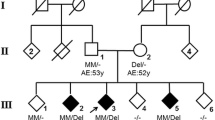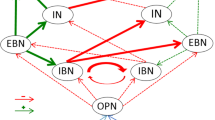Abstract
Ataxia telangiectasia (A-T) typically presents with early-onset progressive cerebellar ataxia, oculomotor apraxia and later, oculo-cutaneous telangiectasia. Extrapyramidal symptoms, apart from chorea, are rare. In this paper, we report a case of A-T with an atypically mild and slowly progressive disease course. Although by history there was mild gait clumsiness in early childhood, the leading problem was that of dystonia with onset at age 15, in the absence of gross gait imbalance or ocular motor apraxia. Dystonia was generalized and with prominent oromandibular involvement. Unusually, a leash of telangiectasia was present on the posterior pharyngeal wall, while other features frequently associated with A-T were absent.



Similar content being viewed by others
References
Chun HH, Gatti RA (2004) Ataxia–telangiectasia, an evolving phenotype. DNA Repair (Amst) 3:1187–1196
Woods CG, Taylor AM (1992) Ataxia telangiectasia in the British Isles: the clinical and laboratory features of 70 affected individuals. Q J Med 82:169–179
Sedgwick RP, Boder E (1991) Ataxia telangiectasia. In: Vinken PJBGKH (ed) Handbook of clinical neurology (hereditary neuropathies and spinocereballar atrophies), vol 60. Elsevier, Amsterdam, The Netherlands, pp 347–423
Taylor AM, Byrd PJ (2005) Molecular pathology of ataxia telangiectasia. J Clin Pathol 58:1009–1015
Perlman S, Becker-Catania S, Gatti RA (2003) Ataxia–telangiectasia: diagnosis and treatment. Semin Pediatr Neurol 10:173–182
Stray-Pedersen A, Borresen-Dale AL, Paus E et al (2007) Alpha fetoprotein is increasing with age in ataxia–telangiectasia. Eur J Paediatr Neurol 11:375–380
Stewart GS, Stankovic T, Byrd PJ et al (2007) RIDDLE immunodeficiency syndrome is linked to defects in 53BP1-mediated DNA damage signaling. Proc Natl Acad Sci U S A 104:16910–16915
Taylor AMR, Metcalfe JA, Thick J et al (1996) Leukemia and lymphoma in ataxia telangiectasia. Blood 87:423–438
Schneider SA, Aggarwal A, Bhatt M et al (2006) Severe tongue protrusion dystonia: clinical syndromes and possible treatment. Neurology 67:940–943
Aguilar MJ, Kamoshita S, Landing BH et al (1968) Pathological observations in ataxia–telangiectasia. A report of five cases. J Neuropathol Exp Neurol 27:659–676
Bodensteiner JB, Goldblum RM, Goldman AS (1980) Progressive dystonia masking ataxia in ataxia–telangiectasia. Arch Neurol 37:464–465
Goyal V, Behari M (2002) Dystonia as presenting manifestation of ataxia telangiectasia: a case report. Neurol India 50:187–189
Koepp M, Schelosky L, Cordes I et al (1994) Dystonia in ataxia telangiectasia: report of a case with putaminal lesions and decreased striatal [123I]iodobenzamide binding. Mov Disord 9:455–459
Stell R, Bronstein AM, Plant GT et al (1989) Ataxia telangiectasia: a reappraisal of the ocular motor features and their value in the diagnosis of atypical cases. Mov Disord 4:320–329
Uziel T, Savitsky K, Platzer M et al (1996) Genomic organization of the ATM gene. Genomics 33:317–320
Gatti RA, Berkel I, Boder E et al (1988) Localization of an ataxia–telangiectasia gene to chromosome 11q22-23. Nature 336:577–580
Gilad S, Chessa L, Khosravi R et al (1998) Genotype–phenotype relationships in ataxia–telangiectasia and variants. Am J Hum Genet 62:551–561
Concannon P, Gatti RA (1997) Diversity of ATM gene mutations detected in patients with ataxia–telangiectasia. Hum Mutat 10:100–107
Buzin CH, Gatti RA, Nguyen VQ et al (2003) Comprehensive scanning of the ATM gene with DOVAM-S. Hum Mutat 21:123–131
Gatti RA, Boder E, Vinters HV et al (1991) Ataxia–telangiectasia: an interdisciplinary approach to pathogenesis. Medicine (Baltimore) 70:99–117
Varon R, Vissinga C, Platzer M et al (1998) Nibrin, a novel DNA double-strand break repair protein, is mutated in Nijmegen breakage syndrome. Cell 93:467–476
Carney JP, Maser RS, Olivares H et al (1998) The hMre11/hRad50 protein complex and Nijmegen breakage syndrome: linkage of double-strand break repair to the cellular DNA damage response. Cell 93:477–486
Uhrhammer N, Bay JO, Bignon YJ (1998) Seventh international workshop on ataxia–telangiectasia. Cancer Res 58:3480–3485
Stewart GS, Maser RS, Stankovic T et al (1999) The DNA double-strand break repair gene hMRE11 is mutated in individuals with an ataxia–telangiectasia-like disorder. Cell 99:577–587
Klein C, Wenning GK, Quinn NP et al (1996) Ataxia without telangiectasia masquerading as benign hereditary chorea. Mov Disord 11:217–220
Hernandez D, McConville CM, Stacey M et al (1993) A family showing no evidence of linkage between the ataxia telangiectasia gene and chromosome 11q22-23. J Med Genet 30:135–140
Perlman SL (2006) Ataxias. Clin Geriatr Med 22:859–77 vii
De Leon GA, Grover WD, Huff DS (1976) Neuropathologic changes in ataxia–telangiectasia. Neurology 26:947–951
Terplan KL, Krauss RF (1969) Histopathologic brain changes in association with ataxia–telangiectasia. Neurology 19:446–454
Acknowledgments
S.A.S. was supported by the Brain Research Trust, UK. AMRT thanks Cancer Research UK and VS the Ataxia Telangiectasia Society of UK for continued support. We also thank Dr Jim Last for technical advice and help.
Author information
Authors and Affiliations
Corresponding author
Additional information
Fatima Carrillo and Susanne A. Schneider contributed equally to the manuscript and should be considered as joint first authors.
Electronic Supplementary Material
Below is the link to the Electronic Supplementary Material.
There is prominent craniocervical dystonia with torticollis to the right and oromandibular involvement with intermittent tongue protrusion which interferes with her speech. When keeping the arms outstretched, there is mild dystonia of the hands. There is no ataxia on the finger nose test. Her gait is narrow-based and there is no difficulty with tandem gait or standing on one foot. Oral examination demonstrates telangiectasia on the left posterior pharyngeal wall. Her eye movements are normal without oculomotor apraxia. (MPG 5.88 MB)
Rights and permissions
About this article
Cite this article
Carrillo, F., Schneider, S.A., Taylor, A.M.R. et al. Prominent Oromandibular Dystonia and Pharyngeal Telangiectasia in Atypical Ataxia Telangiectasia. Cerebellum 8, 22–27 (2009). https://doi.org/10.1007/s12311-008-0055-7
Published:
Issue Date:
DOI: https://doi.org/10.1007/s12311-008-0055-7




